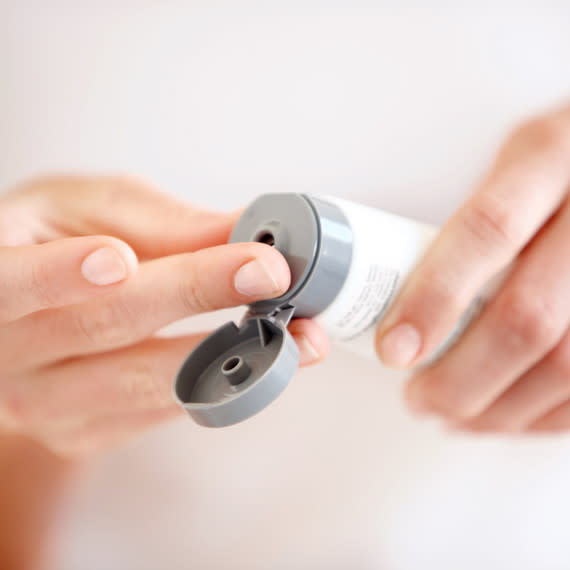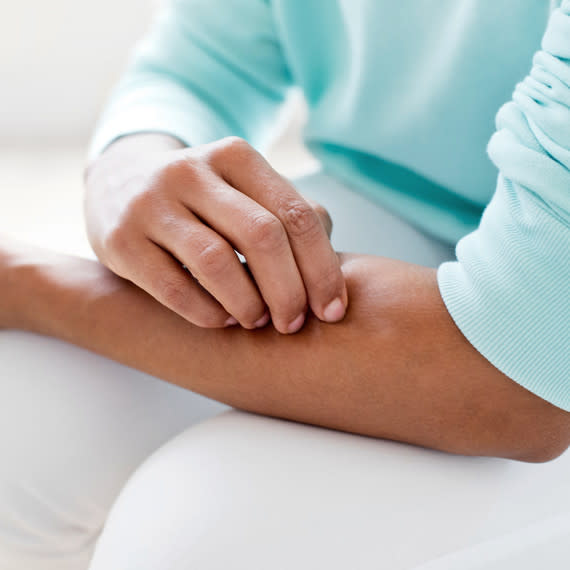How to Prevent Eczema Flares During the Winter

One out of 10 Americans suffers from eczema, a condition defined by red, itchy and inflamed skin. Symptoms of eczema range from mild cases of flaky, irritated hands, to painful blisters that inflict pain and emotional distress.
[TRY: Are CBD Products Right For You]
And anyone dealing with the discomfort knows winters are especially bad. Dr. Jessica Weiser of New York Dermatology Group attributes it to the cold air outside and blasts of heat indoors. “They both deplete the skin of natural moisture, making the skin barrier more compromised, and more susceptible to irritation and allergy,” she explains.
Here’s how to identify, prevent and treat eczema.
The Difference Between Dry Skin and Eczema
Dry skin is not necessarily eczema. “Dry skin is literally just that—kind of flaky, it feels tight, but it’s not red or or inflamed,” explains Dr. Weiser. "Usually when it becomes irritated, itchy, red, more aggravated than just simply dry, we tend to group it into eczematous dermatitis.”
Discomfort is key to identifying the condition says Dr. Emma Guttman, Director of the Center for Excellence in Eczema and the Occupational/Contact Dermatitis Clinic at the Mount Sinai Hospital.
“Patients that have eczema, know they need help because they can’t focus on work or school,” she says. “It sometimes wakes them up at night because there is a very important symptom—the itch.”
In fact, Dr. Guttman says she has even treated patients who were severely depressed due to pain and lack of sleep. “Eczema can affect all of your life. It can put a lot of stress on the entire family,” she says.
[REST: Here's Why Having a Healthy Sleep Routine is So Important]
What Are The Different Types of Eczema
Atopic Dermatitis
Atopic dermatitis is the most common type of eczema. It is a genetically predisposed condition that is chronic and flareups happen as a response to irritants or allergens. People who had eczema as children likely have atopic eczema, and should see their dermatologist about treatment options, which might be topical, oral, laser or biologic (injections).
Contact Dermatitis
Those who did not suffer from eczema as children probably have contact dermatitis: irritant contact dermatitis or allergic contact dermatitis. Irritant contact dermatitis is from exposure to irritating substances and allergens such as chemicals, paints and pet dander. In some cases the trigger isn't necessarily an allergen. People can get flares from over-washing their hands, even with mild soap and water. “They’re probably not allergic, but using soap in excessive amounts can deplete moisture from the skin and make them more prone to inflammation or eczema-type rashes,” Dr. Weiser explains.
Allergic contact dermatitis comes from exposure to topical allergens—not necessarily the same substances that give you hives and make your eyes watery. “It’s a specific ingredient that comes in contact with the skin surface,” explains Dr. Weiser. Those can be anything from preservatives in skincare products, fragrances, or solvents in dry cleaning.
Dyshidrotic eczema
Dyshidrotic eczema is another common form of eczema that is also known as foot-and-hand dermatitis. The condition causes small itchy blisters on fingers, toes, palms and feet. After two to three weeks, the blisters can dry into painful, inflamed skin cracks. Dyshidrotic eczema is twice as common in women as it is in men, and tends to flare more often during spring allergy season.
Allergens like pollen, nickel and cobalt exacerbate dyshidrotic eczema. It’s also important to keep hands and feet away from excessive contact with water—including sweat.
To treat the condition Dr. Guttman prescribes a stronger steroid for a week followed by a milder one. She also sometimes prescribes a topical non-steroidal treatment. Though many of her patients with foot-and-hand dermatitis also get excimer laser treatment. “It’s a form of phototherapy that can target localized areas,” she explains. “It’s often covered by insurance.”
[CLEAN: How to Reduce Allergies at Home]
Some Allergens to Watch Out For
Typical allergens include propylene glycol, sometimes found in cosmetics; or nickel, commonly used for costume jewelry. “Allergies increase in life, and if you have a background in eczema, you could have even more [allergies]," says Dr. Guttman. "It’s important for these patients to do patch allergy testing.”
Best Products to Prevent Eczema Flares
People with less severe eczema can manage the condition by taking preventive measures. Unsurprisingly, moisturizing is key— but be gentle. Look out for mild products with few or no preservatives. Dr. Weiser swears by Vanicream for the face, and advises patients to look for products with hyaluronic acid or glycerine. She’s also a fan of layering a hydrating serum under a moisturizer. “You’re trapping an extra layer of moisture underneath,” she explains. And if you use “milky or gel” moisturizers in the summer, switch to something more substantial when it gets cold. Other products she recommends: Drunk Elephant B-Hydra Serum, Neocutis Hyalis Serum and for very sensitive skin, products from La Roche-Posay’s Toleriane line. For patients with combination skin or acne, she suggests lighter moisturizers like Tatcha Water Cream or Peter Thomas Roth Oil-Free Moisturizer. Dr. Guttman prefers pharmacy standbys like Cerave, Aquaphor, Cetaphil, Aveeno and even petroleum jelly on problem areas.
Natural Remedies
Some patients prefer natural products. Vitamin D might help protect against flares, and some find relief from massage, acupuncture and probiotics. Dr. Weiser says some of her patients use natural oils as well.
“I have patients using coconut oil—or whatever appeals to your skin,” she says. But if you are using oils, try layering your products. For example she recommending using rosehip oil or grapeseed oil, then trapping it in the skin with a heavier cream.

What you wear makes a difference
Scratchy wool can make eczema worse, for example, and so can not protecting your skin against the elements. “Wear gloves every time you go outside in the winter to prevent chafing in cold weather,” advises Dr. Weiser. But getting sweaty can exacerbate eczema, so be sure to dress in layers that let you adapt to different temperatures. It’s also helpful to keep a humidifier in your home to add moisture to the dry air, especially in the wintertime.
Gentle Cleansing
Cleansing is another time patients need to be careful. Dr. Guttman says people who have eczema should use a non-irritating cleanser like Cetaphil, but they can also skip soap and just use water if they are having a very painful flare. Unfortunately, one cold weather favorite is out for people with eczema: hot baths. “The hotter the shower, the more drying it is,” says Dr. Weiser, who stresses moisturizing right after a bath or shower to trap hydration into the skin. Another important tip: take five to 10 minute showers.
Treating Eczema Flares
Dr. Guttman says patients should see their doctors immediately when they have eczema flares, to nip it in the bud. “The secret to good treatment is to tackle it early, when it’s localized and you can really treat it well,” she says. Persistent eczema is a serious issue, and both doctors agree that it’s not wise to lean on cortisone creams for long periods without a doctor’s guidance, as they can thin the skin and lead to stretch marks. A dermatologist can prescribe a cortisone cream at an appropriate dosage for your needs, nonsteroidal cream or oral medication. For more severe situations they can suggest phototherapy or injections.
Phototherapy
Phototherapy, or light therapy, is a treatment option for patients who have not responded to topical treatments. Overactive immune system cells in the skin can cause inflammation in eczema patients, and UV light helps shut down these immune system cells. The light is the same type of light as natural sunlight, but has been altered to remove certain wavelengths that are harmful to the skin. The most common form of light therapy is narrowband UVB light, which is administered through a special machine. Approximately 70 percent of eczema patients see their symptoms improve after phototherapy. However, Dr. Guttman points out that it’s a time commitment. The treatment requires patients to come in to the doctor’s office two to three times a week for several months.
(function(d, s, id) { if (d.getElementById(id)) return; var js = d.createElement(s); js.id = id; js.src = '//cdn4.wibbitz.com/static.js'; d.getElementsByTagName('body')[0].appendChild(js); }(document, 'script', 'wibbitz-static-embed'));

